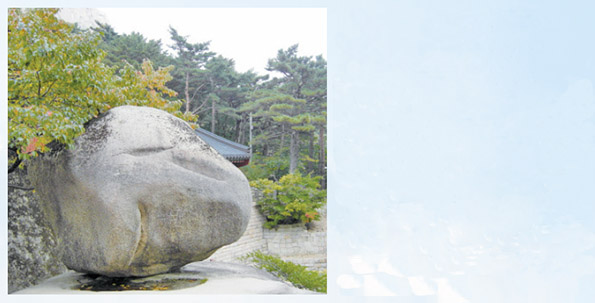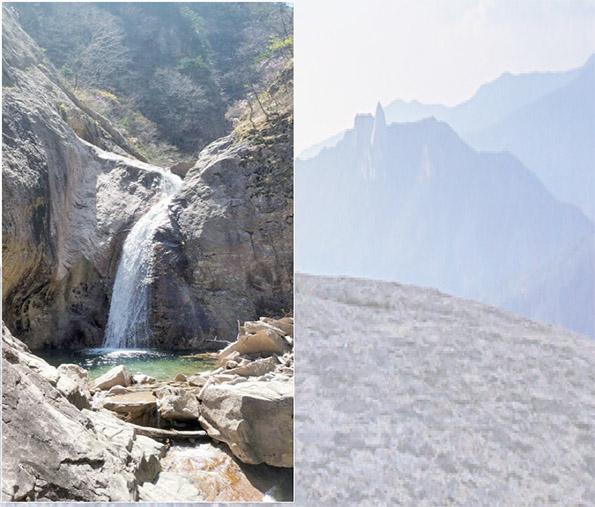
This article was penned for busy modern people. Due to busy schedules and the COVID-19 pandemic, modern people spend more time indoors. While staying indoors, people often feel depressed and frustrated. Therefore, CBT reporters recommend visiting ‘Mt. Seorak’, which has just turned lush and green to mark early summer. Of course, visitors should follow quarantine guidelines, wearing masks, and social distancing. In this article we will introduce the four courses of Mt. Seorak. We booked a guesthouse nearby Mt. Seorak and visited Move-rock and Gwongeumseong Course on the first day, and Biseondae Rock and Geumganggul on the second day.
History of Mt. Seorak
Before traveling there, reporters researched the history of Mt. Seorak. According to Geographical Analysis of Mt. Seorak’s Natural Geography History during the Joseon Dynasty period, the mountain’s geographical domain is different in modern times compared to the Joseon Dynasty period. Nowadays, Mt Seorak’s range includes Dae-Cheong bong Peak, Ul-san Rock, and Han-gye ryeong’s northern range. However, in the Joseon Dynasty period, only the area centered on Dae-Cheong bong Peak was included in the range of Mt. Seorak. At the time, Ulsan Rock was called Mt. Cheon-hu and Han-gye ryeong’s north range was called Mt. Hangye. Through this information, reporters were well-informed of the basic history of Mt. Seorak and reporters finally headed to Mt. Seorak, with great anticipation.
Move-rock Course [More Novice Course]
To see Move-rock, which can be commonly seen in textbooks and childhood fairy tales, reporters had to go through several places. First, reporters started from Small Park. Reporters started walking refreshed and confident from the Small park. The path was flat and wide and it felt motivated to take a walk. Reporters gradually started to encounter steps and stairs made of rocks but it was all quite manageable.
Along the way, reporters encountered a temple called Shin-heung, which is famous for its huge Buddha statue. When reporters saw it in reality, it was even grander, so reporters felt a sense of incompatibility. Also, Seorak is a rocky mountain, there were so many stone walls and even the brook was half water and half stone.
Then, unexpectedly, reporters looked up and saw a temple, which meant that reporters finally arrived at Move-rock. Move-rock was a bit disappointing at first because it was smaller than expected. However, reporters proceeded to take some photos and to try to rock it. According to custom the rock will actually move if visitors push on it, but it didn’t move at all until several people pushed together and finally it moved a little. Reporters took a well-deserved rest around the rock and then went down the mountain. It took about an hour from the Small park to the Move-rock. There was a road from Move-rock to Ulsan-Rock, but Move-rock was the goal, so reporters decided to go back the way reporters came. It takes about two hours both ways. Reporters recommend the Move-rock courses for beginners who are not familiar with hiking and those who have young children.
Gwongeumseong Course, [More Novice Course]
Next, reporters tackled the Gwongeumseong course from which Ulsan-rock, Sokcho-si, and the sea can be seen. It is a three-kilometer round trip to and from Gwongeumseong Fortress which includes a cable car ride, and it takes about an hour. The course has the advantage of making the highlands easily accessible for the elderly, children, and the disabled.
It was quite a long way from the entrance to the cable car. Still, visitors can get there comfortably by using a shuttle bus that runs every 10 minutes. The entrance fee was about 3,500 won for adults and 1,000 won for high school students. Reporters visited the ‘Gwongeumseong Restaurant’ which is also known as the famous restaurant of Mt. Seorak. Reporters ate seafood onion pancake and acorn jelly there and it was very delicious. Then, reporters found the ticket office for the cable car, and waited for about an hour because it was fully booked. The fee is 11,000 won for adults.
When it was reporter’s turn to go up by cable car, it was nice to see green grass and trees welcoming people in early summer. Also, it was good to hear an explanation about the surrounding scenery over the speakers in the cable car. Once reporters got off the cable car, huge rocks greeted visitors. Reporters could immediately see the ruins of Gwongeumseong Fortress, which is a place of historical significance. The area around the Fortress is composed of various geographical features, including Resistance Decree and Janggunbong Peak. The name was given to people with Kim’s last name because they built a wall in a day to avoid Mongol invasions during the Goryeo Dynasty. Gwongeumseong portrays a scene from Korea fierce history.
Biseondae Rock Natural Observation [Novice Course]
Biseondae Rock course is considered to be the best course to go to on in the early summer at Mt. Seorak National Park. The Biseondae Rock Nature Observatory trail starts at a Small park, passes through Sinheungsa Temple, and goes to Waseondae and Biseondae Rock. It is 3km one-way and takes about 1 hour and 20 minutes. Reporters followed the path to Sinheung Temple from Small Park. At first, the road was so flat that strollers and babies could easily walk it, but later a gradual sloping of stone stairs appeared. As visitors walk, visitors will see a sign, which explains in detail as to what scenery people can find. It was impressive that the leaves of the trees were gently swaying when the wind blew. The sound of water began to be heard, and after a while the Waseondae Rock began to appear. Also, the Biseondae Rock course runs a national interpretation program. If visitors have more than 10 companions visitors can book the national interpretation program by phone. It’s a great place for families and school groups to explore.
Geumganggul Cave Course [Novice Course]
The Geumganggul Cave course is also an easy road for beginners to explore the mountain. The course consists of ‘Small Park, Waseondae Rock, Biseondae Rock and Geumganggul Cave.’ Reporters started from a Small Park, the same starting point as the previous day. Reporters felt good because the air was fresh and cool, probably because of the mountain. There was a valley under a bridge with clear mountain water, so reporters could see everything inside, and realize how beautiful the undefiled nature was.
As reporters continued to walk, the Geumgang pine tree colony unfolded in front of reporters. The freshness of the pine trees was like balm which soothed visitor’s eyes. Again, reporters walked for about 30 minutes and saw the Waseondae Rock. Large white rocks were embedded in the valley, it was like reporters had met another mountain. Reporters went down to the valley and had a little break before walking along the constant stairs. Next, there was a bridge. The large rock, in front of the bridge, was named ‘Sin-seon dae’, and above it was ‘Seon-nyeo peak’ and ‘Janggun peak.’ Reporters enjoyed the sight of various mountain peaks around Sin-seon dae. This is where the tough hiking course started, and also where reporters started sweating profusely. This section is aptly called ‘Kkal-ttag Mountain Passes’ which means ‘breathless.’ Reporters constantly encountered steeper stairs. However, the scenery was healing. The dense mountain peaks, woody pine trees, the rocks created by nature, convinced reporters that the expression ‘nature is great’ must have first been coined here.
After climbing the iron stairs without saying a word, reporters finally reached reporters’ destination, Geumganggul Cave. It was very interesting that there was a cave on the mountain, and reporters enjoyed the beautiful scenery freely. Reporters turned back and went down the mountain after taking pictures. Reporters’ legs were like jelly, but it was less difficult than when reporters went up. If reporters have a chance, reporters want to try a more difficult course next time. It is said that mountains emit better energy than seas. The phytoncide and fresh air gave visitors a lot of energy. Reporters sincerely hope that COVID-19 ends as soon as possible, so people could take off the mask and go hiking. If you are depressed by COVID-19 and feel lethargic because of staying at home, reporters recommend that you to go to Mt. Seorak to soak in the energy of the mountain.
By Lee Sang-min l 0l6s2m0@cbnu.ac.kr
By Hong soo-min l sm41@cbnu.ac.kr


 All
All Experience
Experience






 Lee Sang-min&Hong soo-min
Lee Sang-min&Hong soo-min











